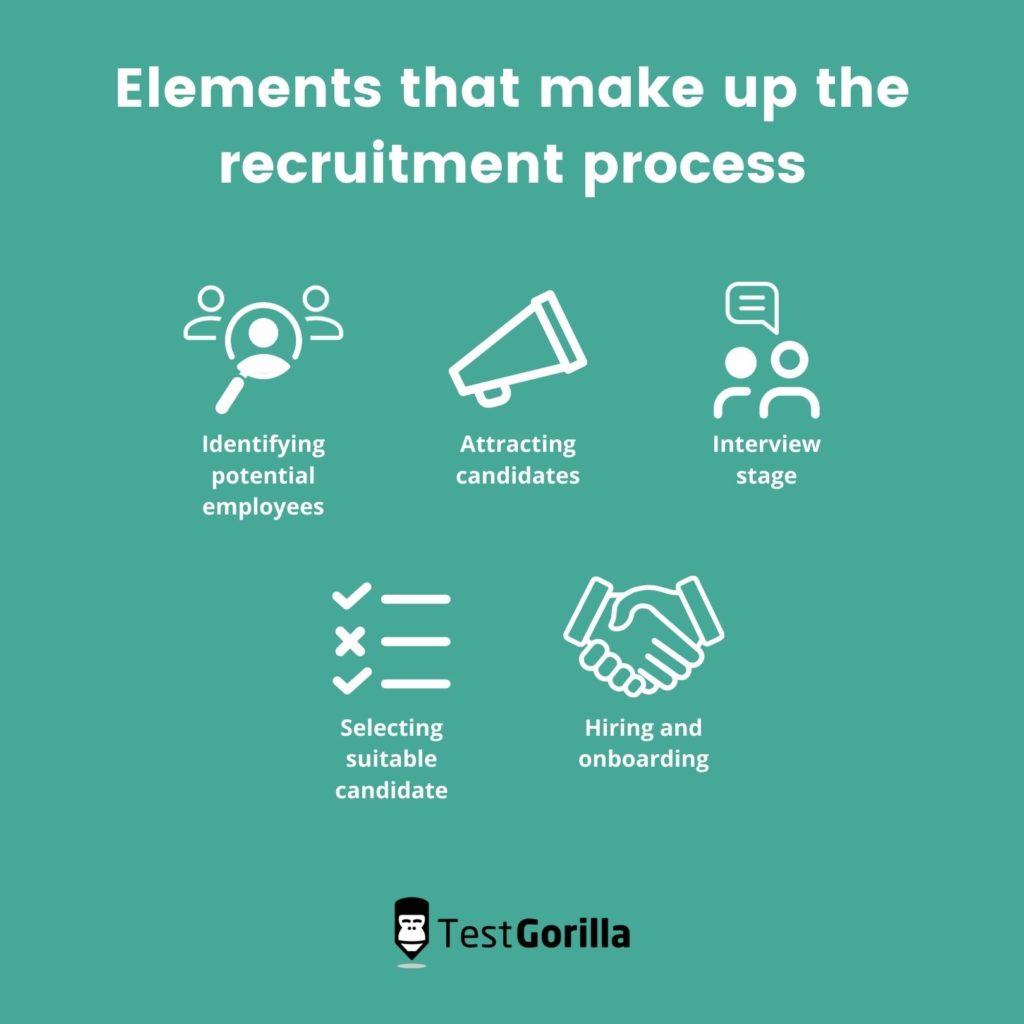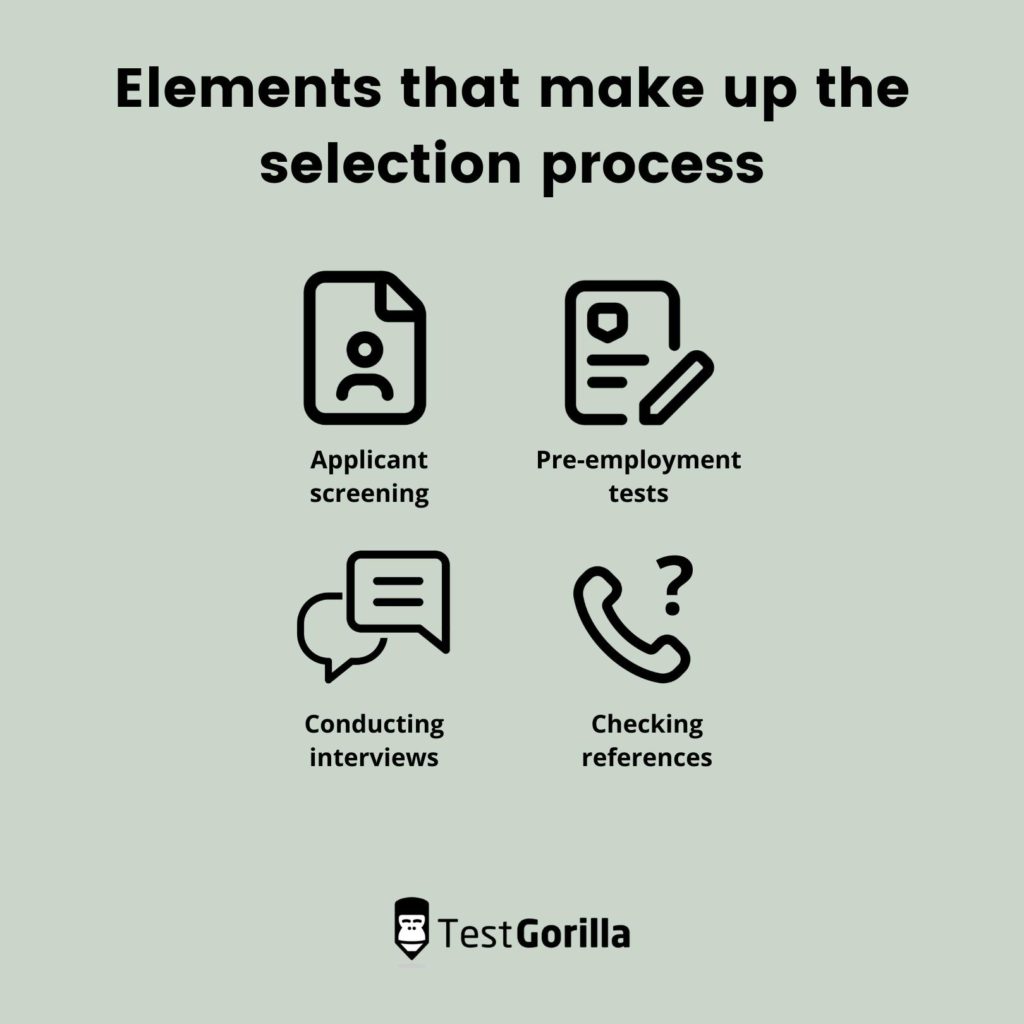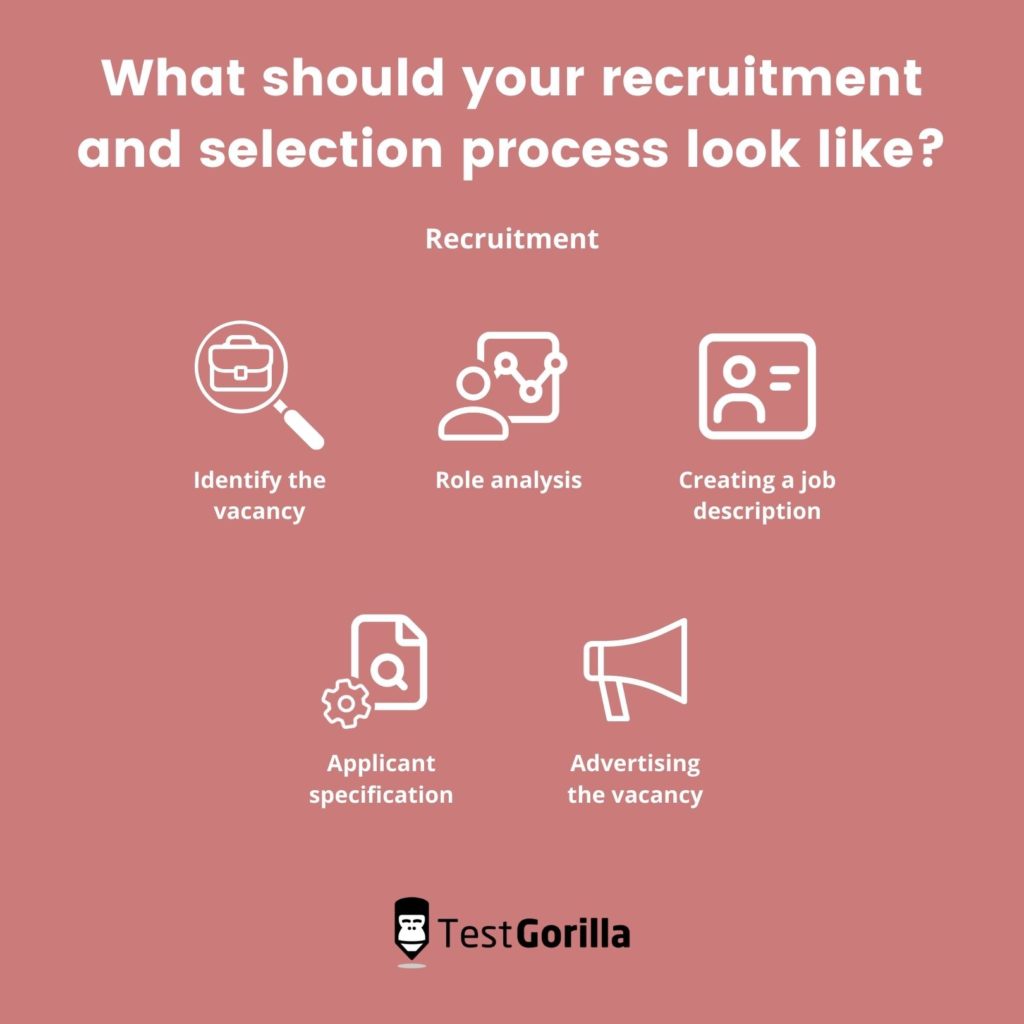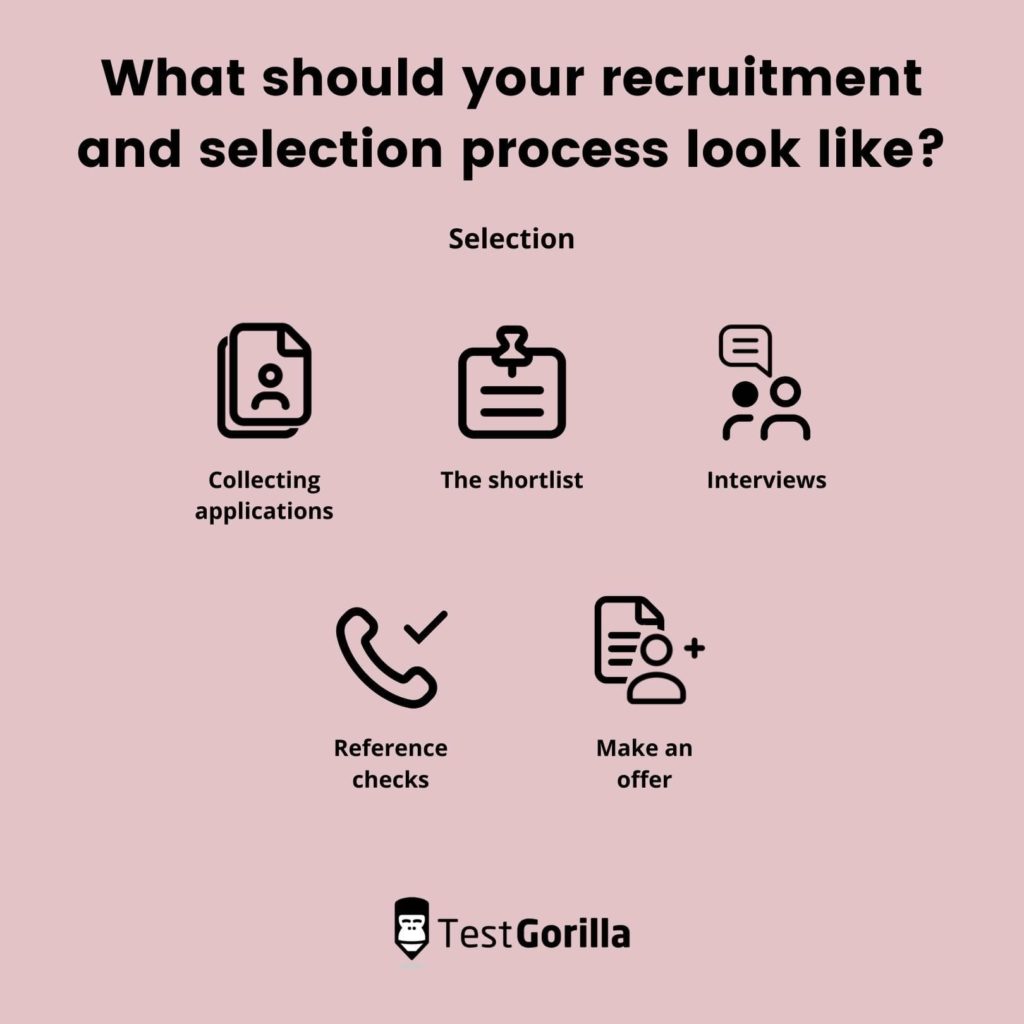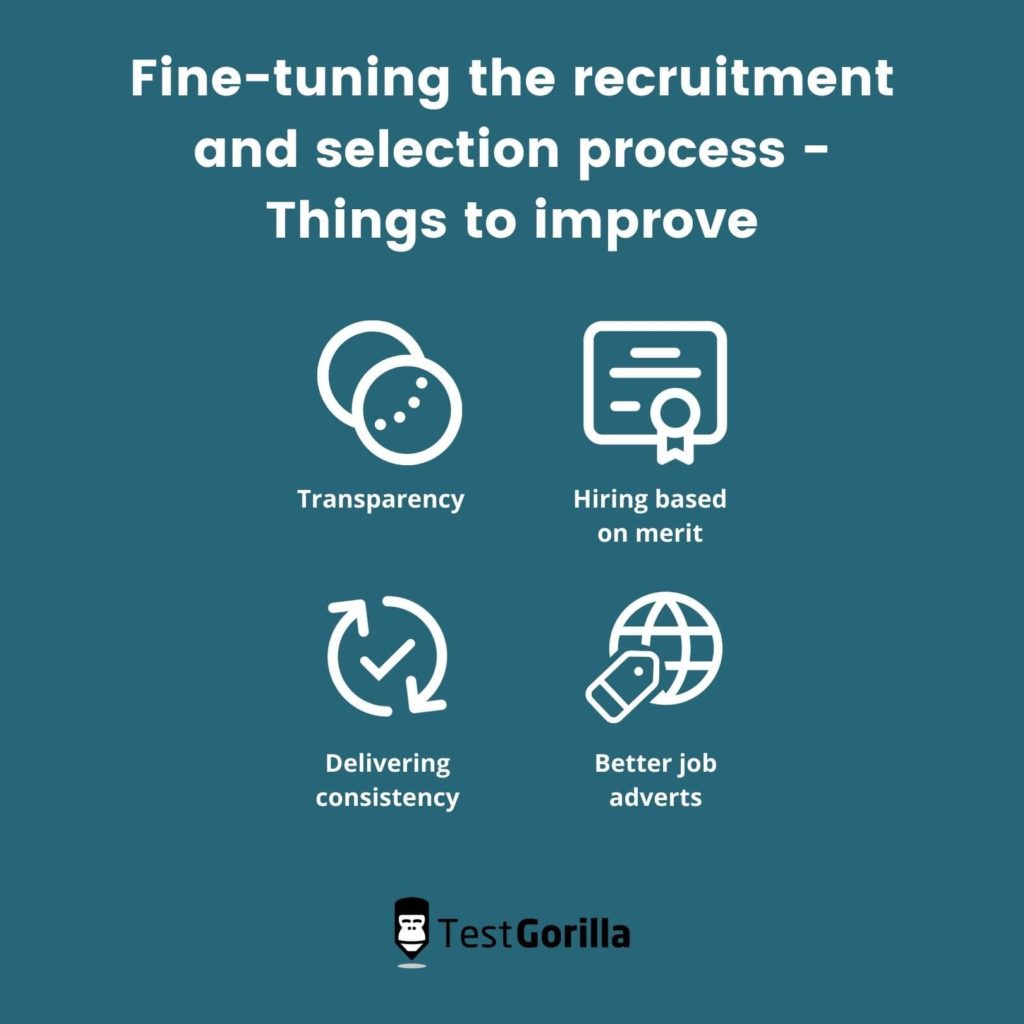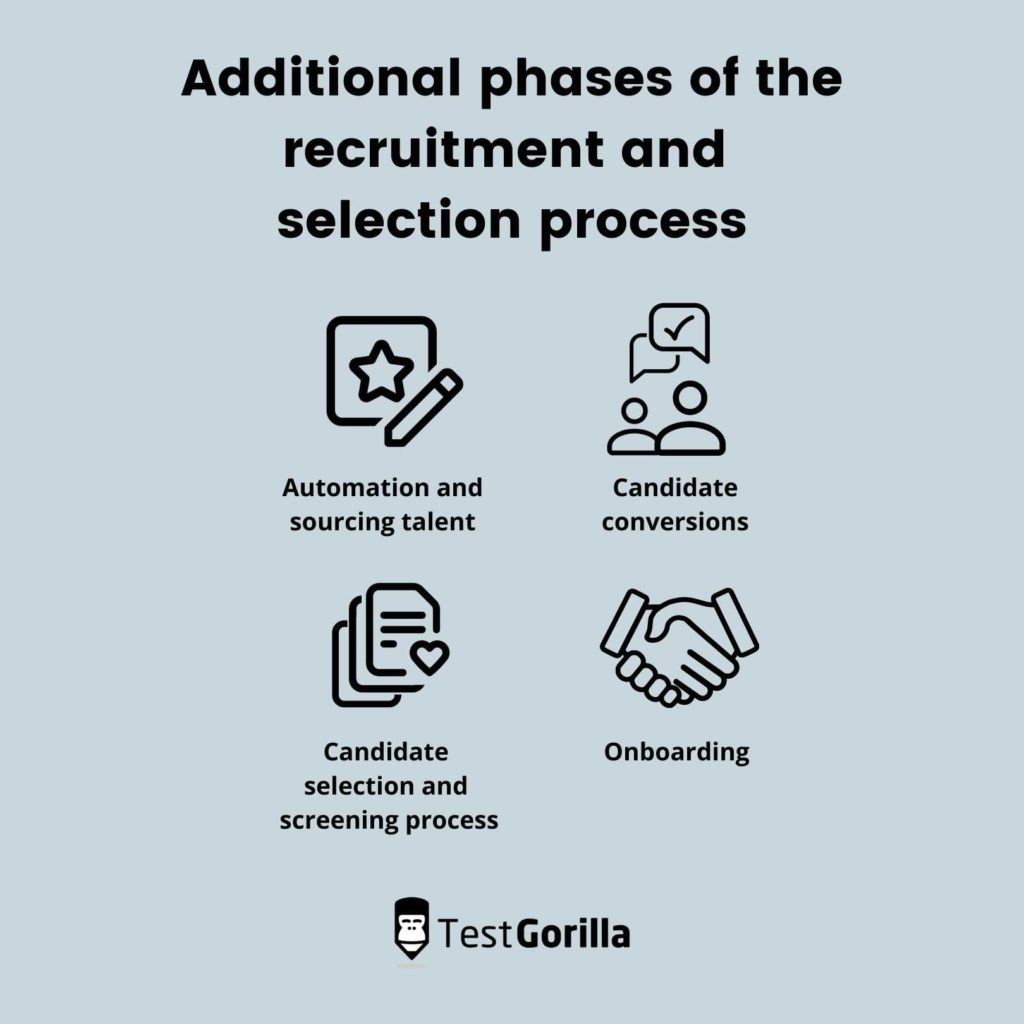Recruitment and selection can cost the average company around $500 a day.
Despite the cost, only 19% of hires are considered successful. So how do you refine the recruitment and selection process while ensuring that you get the best candidates?
Improving the recruitment and selection process remains a challenge. With the right recruitment planning and an awareness of the main challenges, your HR team can make changes, ensuring that you make the right hiring decision every time.
Table of contents
- What is recruitment?
- What is selection?
- The difference between recruitment and selection
- Aligning recruitment and selection to build a better workforce
- What should your recruitment and selection process look like?
- How to fine-tune your recruitment and selection process
- What are the main objectives of the recruitment and selection process?
- Principles of the recruitment and selection process
- Additional phases of the recruitment and selection process
- What are the common problems in recruitment and selection?
- Improve your recruitment and selection process with TestGorilla
What is recruitment?
Recruitment refers simply to the process of hiring new staff. That process involves the following elements:
Identifying potential employees
Attracting candidates so that they apply for vacancies
The interview stage
Selecting the most suitable candidate
Hiring and onboarding
Recruitment also involves a range of focused tasks that need to be carried out correctly. These are:
Understanding the need for a new employee
Analysing the requirements of the role
Creating the job advert
Using the right advertising channels to attract the right applicants
Managing the response to every job advert
Monitoring applications
Beginning the shortlisting process
Depending on your organisation’s needs, there may be additional steps, but optimizing how each of the above is executed is key to successful recruitment.
What is selection?
With recruitment, you attract talent; now it’s time to qualify them for the next stage. The initial goal here is to separate the unqualified and qualified applications.
This stage can include some or all of the following steps:
Applicant screening
Pre-employment tests (these can vary wildly, and may include job knowledge tests, personality tests, skills evaluation tests, or cognitive ability tests etc)
Conducting interviews
Checking any provided references
While the process of recruitment from start to finish can be incredibly time-consuming, the selection process is often the most laborious.
The best insights on HR and recruitment, delivered to your inbox.
Biweekly updates. No spam. Unsubscribe any time.
The difference between recruitment and selection
Recruitment is the task of developing ways to attract the most suitable candidates. Selection is the methodology used to identify the best applicant for every vacancy.
Recruitment is considered simpler because you’re focused on attracting the right talent, not scrutinizing it. Selection, on the other hand, involves digging much deeper and evaluating each candidate in terms of their:
Ability to do the job well
Attitude and personality
Cultural fit
Ambition and drive
These have to align with whatever else your organization deems ideal criteria for the position at hand.
Aligning recruitment and selection to build a better workforce
If your recruitment efforts are on-point, selection will automatically go smoother because you’d receive more relevant applications. Evaluation will be faster, and you’ll only be sifting through a qualified pool and therefore increasing your chances of finding the ideal fit.
If the recruitment process is strong enough, companies may also end up with a better hire than they originally expected. That’s why it’s crucial to align recruitment and selection.
Aligning the needs of the organisation and the competencies of the workforce is essential. The solution is more thorough workforce planning.
To more competently fill a vacancy, HR needs to understand the goals of the business and then align recruitment to match those goals. That means it’s the responsibility of HR to:
Understand the strategic goals of the business
Identify the competencies the business needs to acquire to meet those goals
Perform a talent analysis of existing employees (in-house recruitment is faster and more cost-effective)
Understand the availability of core competencies in the current labour market
Fill the gaps between existing competencies and those needed (this could highlight the need for a talent-building program for employee development, or narrow down the essential requirements of a new hire)
Collaboration between every member of the HR team is vital, and the two-way flow of communication needs to be prioritised. It’s important to understand that there must be a substantial amount of time and money devoted to this process.
What should your recruitment and selection process look like?
No two companies have the same recruitment and selection strategy, but it generally centers on the steps outlined here:
1. Recruitment – Identifying the vacancy
There are many reasons why the need to make a hire might become essential. You may need to replace an employee who has moved to a different company, or replace someone who has been promoted or has moved to another department. It could simply be that the company has grown and requires new team members.
In some cases, business growth means accessing new skills that were previously unnecessary in the organisational structure. These can be much more difficult to identify if the HR team is not engaged in continuous communication with management teams.
2. Recruitment – Role analysis
With the vacancy identified, you need to develop a deep understanding of what the role requires and which skill set would best complement the team.
This step is called job analysis and evaluation and the findings are used to help create the job advertisement. The more research you put into this step, the stronger the job advert, and therefore, the smoother the subsequent candidate selection process. In some cases, you may find that the vacancy can be filled internally.
3. Recruitment – Creating a job description
The job description can vary depending on the brand’s voice and workplace culture. However, every job description should include the following:
The duties of the position
The salary range
The geographical location (or whether the position is ‘remote’)
How many hours a week the role requires
Remember that this isn’t the job advertisement; you’re just creating the outline.
4. Recruitment – Applicant specification
The next step is to identify what the ideal candidate looks like. This will be a list of the qualifications and specific skills that the HR team and relevant department heads consider is needed to do the job well. Getting the specifications right helps cut down the time it takes to review and shortlist applications.
5. Recruitment – Advertising the vacancy
Now that the recruitment team knows what the role entails and what kind of person they’re looking for, the vacancy needs to be advertised. Whether you’re hiring internally or opting for external sources of recruitment, the goal here is to receive as many relevant applications as possible. That means choosing your advertising channels carefully.
If you’re only advertising for internal recruitment, then you will be using notice boards or an in-house intranet to display the ad. Referral programs are also a powerful strategy to consider when hiring internally, especially for organizations with a global spread. For external recruitment, you have more options than ever. One can even apply for a job via TikTok or Facebook now.
There are plenty of job advert platforms, and HR teams can use everything from LinkedIn to Indeed. You can also use your local press, recruitment agencies, or rely on employee referrals. The goal is to make sure that you get a large number of relevant applicants.
6. Selection – Collecting applications
Once you have started to receive applications, they need to be analyzed. All of the information that’s presented needs to be compared with other applicants and against the person’s specifications that have already been identified.
Remember to make sure that candidates can apply in the ways that are most convenient for them. Some will be applying using their PCs, others might be job searching via their phones. Whichever channels you use to advertise a role and collect applications, make certain that it offers flexibility in terms of device and process.
7. Selection – The shortlist
Applications now need to be evaluated and shortlisted for the interview process. This involves going through each application, matching it to the person specifications, and comparing shortlisted candidates for a final round of shortlisting.
You can speed up this stage of the process (and the whole recruitment process) by using scientifically proven screening assessments that also add accuracy and a bias-free component to recruitment. These tests make it much easier to determine who should be invited to the next stage of the hiring process.
8. Selection – Interviews
The interview process is a complex one. There are millions of articles, books, and in-house manuals on job interviews. At its most basic, a job interview is where qualified candidates find out more about the company and the company learns more about the applicant.
Job interviews take many forms, including:
One-on-one
Panel interviews
Group interviews (multiple candidates at the same time)
Remote interviews (via phone or video)
A job interview may also be paired with additional testing. Practical assessments are increasingly common, testing aptitude, intelligence, or physical ability.
Skills assessment testing isn’t used by everyone during the interview stage, but it’s one of the best ways to make sure that you hire the best candidates. It allows you to see how well your applicants respond to pressure, which is useful for gauging their response to the expected workload.
9. Selection – Reference checks
During the interview process, one area that is frequently being overlooked is the need for a candidate to provide references. The reason this is much rarer than it used to be is that it’s far too easy to game the system.
Too many applicants provide false information and false references. However, those references need to be checked thoroughly. Anyone providing falsified references can be removed from the shortlist.
These days, it’s very common to either overlook the reference check stage of the recruitment process or leave it until a late stage. However, if faced with applicants that are equally suited to a role, reference checks can help determine who to make an offer to. References can also be used to put aside applicants who aren’t a good cultural fit.
References still need to be checked. With so many job seekers applying for roles, there’s a tendency for resume exaggerations or even outright lies.
A general rule of thumb to remember is that the more responsibilities a role has, the earlier in the recruitment process their references should be checked.
However, the majority of reference checks happen during the later stages of the hiring process. In some cases, reference checking will be a two-stage process: written requests at the early stages of the process, and more detailed and in-depth checks done via phone call during the later stages. More junior roles will tend to forgo the more in-depth check.
The next issue for HR to tackle is who is providing the reference. Some organizations have a policy where they will only give certain facts about a previous employee (dates of employment, salary details, job responsibilities). Others will pass your requests to an HR member. It sometimes requires a lot of persistence to talk to someone who can give you the information that you need. Ideally, you want to communicate directly with a line manager.
Personal references are still a common sight on resumes, but these can largely be ignored. It’s not likely that you’re going to get any value from references provided by friends or family. If a candidate has no previous paid work experience, then their references may include teachers or managers at volunteering organizations. These will be more useful than references from non-professional sources.
The information that you ask for from references is also important to get right. In the first instance of a basic written reference, the questions you need answers to include:
Employment dates
Job role and the responsibilities
Total number of sick days taken, and the applicant’s attendance record
General overview of work ethic (honest, reliable, hard-worker)
Any instances of complaints or disciplinary actions
More in-depth reference checks will allow you to get down to the finer details. The goal of reference checking is to ensure that the applicant is going to fit the role as well as possible, and that means:
Asking about the candidate’s work strengths
Explaining the responsibilities of the role and whether the referee believes the candidate is capable of those responsibilities
Finding out how the candidate related to different management styles, and the workplace environments they are most productive in
Discussing why the candidate left a role
Asking whether the previous employer would consider reheating the candidate
A top tip when asking questions of referees is to make sure that you only ask open-ended questions. Avoid those that allow for a yes or no response.
Likewise, don’t ask questions that are designed to reflect poorly on the candidate. If the person being used as a reference is asked about the weaknesses of a candidate, they may feel uncomfortable. That means you won’t get reliable answers.
Some final factors to think about when conducting or considering reference checks include:
Reference check every new hire, even for volunteering roles or unpaid internships
Remember that there are legal guidelines to follow when you request a reference or a background check
Prepare your reference questions in advance, and stay consistent when checking the references of every candidate
10. Selection – Make an offer
The final stage of the selection process is to make an offer to the right applicant for the position. This can be done over the phone, via email, or even by post. In some cases, the HR team will call the person into the work environment to offer them the position.
At times, your chosen candidate may not be happy with some of the basics (salary, work condition, etc). That will mean entering a negotiation stage or turning your attention to one of the previously shortlisted candidates.
There’s also the issue of candidate ghosting. A common complaint among job seekers is about the time it takes to apply for a role only to never hear from the business. HR teams are now seeing the opposite.
Offering someone a role and then never hearing from them again is increasingly common. It can be a major blow to the recruiters and can add costs to recruitment. It’s an incredibly disruptive event, and may even result in having to start the entire recruitment cycle from scratch.
To reduce the risks of being ghosted by applicants, HR has a few options to consider.
Interview stacking: Some recruiters are making appointments for more interviews that they can feasibly fit into a day. They are aware that some applicants are not going to show up, and so they maximise the number of people who will. There are obvious risks to this strategy, but it can be useful for more junior roles that have a higher chance of absent interviewees.
Constant recruitment: One high-level option to consider is to always be recruiting. HR needs to be networking at all times, becoming more visible to candidates even if they aren’t on the lookout for a new role.
Go faster: One of the most common reasons for a candidate ghosting is simply because the recruitment process itself is taking too long. How can you reduce time to hire? Make the process shorter, introduce assessment tests to speed up screening, and lower the number of interviews.
How to fine-tune your recruitment and selection process
Perfecting the recruitment and selection process means an organisation gains some serious advantages. That means finding ways to improve the following.
1. Transparency
A more transparent recruitment process improves the experience for the recruiters and the candidates. One of the biggest complaints about recruitment is that the realities of the advertised position are not reflected in the advertisement for those positions. Issues with salary, benefits, or responsibilities will leave new hires frustrated and they will be less likely to be productive.
Ignoring the importance of transparency means that candidates will be left feeling negative. There will be more people ghosting or dropping out of the hiring process, and more offers that are declined.
The trust element is often overlooked by recruiters, but it’s an important aspect to get right. More trust means more credibility for the business, and transparency boosts trust. More communication, more honesty, and more realism when discussing and advertising a position will go a long way to attracting the right candidates. That’s going to mean:
Creating realistic job adverts: Don’t try to oversell the positive aspect of the job or overlook the harder aspects. If you’re skipping over parts of the job then that’s going to mean nasty surprises for the candidate if they accept the position.
Have a realistic recruitment timeline: Let your candidates know how long they’re going to have to wait to hear a response from you. That means at every stage of the recruitment process. If they have submitted an application form or resume, make sure that they receive an email thanking them for it and letting them know how long it will be before they hear a response.
Let them know if their application has not been successful. Make it very clear how long they can expect to wait for a decision after you have run interviews. Keep them updated and your candidates will appreciate it.
List a salary: One of the biggest complaints about finding work right now is how many job adverts fail to list a salary range. Now, this is an ongoing discussion among HR professionals, and most will have a very strong opinion on it.
However, although there are benefits to not listing a salary (such as making sure competitors can’t outbid on top performers etc), the fact is that including salary details has many positive effects.
More applications (particularly from millennials)
More transparency
Less time-waste
Provide feedback: Another of the big complaints about modern recruitment is the lack of communication after an interview. As part of a more transparent recruitment process, make sure that even unsuccessful candidates get feedback. This may encourage them to work on their skills, meaning they could be excellent hires in the future. Let candidates know where they need to improve and the business can earn long-term credibility.
With a more transparent process, the hiring manager and the HR team will have more confidence regarding the final decision. They will be connected at every stage of the process, making communication and collaboration as straightforward and seamless as possible.
2. Hiring based on merit
Bias can be either conscious or unconscious, and it hurts both recruitment and the overall goals of any business. By fine-tuning recruitment so that it relies on merit-based hires, the organisation only grows stronger.
The best way to accomplish this is through the use of a pre-employment assessment test. These will be anonymized, ensuring that conscious and unconscious hiring bias is avoided. If HR ignores the potential for bias, you risk missing out on top talent.
3. Delivering consistency
Recruitment is like any other business process. The recruitment process needs to be standardised and then followed to the letter. Ideally, the HR team should have a series of clear steps in place at every stage of the recruitment and selection process.
It starts with the job analysis. Recruiters need to identify the skills and knowledge that are required for the role, and then list those in job adverts. Ads must be free from any aspects that are not related to the candidate’s ability to do the job.
To deliver a more consistent recruitment process, hiring managers and recruiters should also have a high level of training. They will need to know all of the basics such as employment law and basic interviewing skills. If interviewers ask questions about sexual identity, disabilities, age, etc, then the hiring process will be hindered.
Fair testing of candidates that only gauges the potential for job performance rather than background history means fairer and more consistent recruitment.
Not only does this ensure that unconscious bias is avoided, but it also ensures that the business is not exposed to litigation and compensation risks. Having a clear and definable recruitment roadmap is vital.
4. Better job adverts
A job advertisement is often the first touchpoint for a potential hire. They will read through the criteria, the duties, and the salary and then decide whether the role is a good fit for them.
To create better job ads, focus on the following:
Job title: Don’t use internal job titles, jargon, or any acronyms. You might be used to them, but candidates may not be. Remember that many job seekers will be using search functions to find roles, and they’re less likely to search for ‘customer service ninja’ than ‘customer service jobs’. Stick to recognisable and common job title names.
List positives: Next, you want to sell the role to potential candidates. Highlight what’s great about the role and the company. Take time to consider what is going to attract the right applications. A good way to identify the positives of a position and the business is to simply ask current team members.
Include a summary: In the final part of the job ad, use a summary of the role that will make it easier for a candidate to see themselves in that job. Use a call to action to finish off.
Recommended reading: How to write great job descriptions [job description template included]
What are the main objectives of the recruitment and selection process?
The main objective of the recruitment and selection process is to ensure that the best person is chosen to fill the current vacancy. However, there are additional objectives that are often overlooked:
Ensure job postings appeal to a high number of people
Identifying applicants that will fit the company culture
Reduce the risk of a hire handing in their notice after only a brief time
Hire based on merit so that the brand’s social and diversity commitments are met
Improve brand reputation via the use of an unbiased, effective, and fair hiring process
Collect details of excellent candidates who may be interested in a position in the future
Continuously evaluate the effectiveness of the existing recruitment process, and making changes as needed
Each of the above has several moving parts, necessitating specialist HR roles.
Principles of the recruitment and selection process
A recruitment process flowchart is considered a mainstay, helping you improve your decisions. Making sure it is easily understood across HR is essential. By implementing this resource the decision-making process is accelerated.
The pointers below will help you create a solid foundation for your recruitment and selection flowchart:
Keep it simple
Make the process easy to navigate
Identify the most important steps in the recruitment process
Highlight the key decision points
Identify the recruitment channels that will be utilised
Additional phases of the recruitment and selection process
The recruitment and selection phases will include the initial preparation, sourcing the candidates, making selections, running interviews, conducting reference checks, and finally the onboarding stage.
To attract the top candidates for advertised positions, every phase needs to be fully optimized. As well as the basic recruitment roadmap, recruiters also need to consider these additional phases of hiring.
1. Automation and sourcing talent
Too often, the applicant experience is frustrating, drawn-out, and opaque. This leads to long waiting times for a decision to be made, or an excessive number of hoops for the candidate to jump through. A frustrating experience is a huge turn off for candidates.
That’s why you need to create a recruitment and selection process that is as communicative and well-structured as possible. There are now many applicant tracking systems available that can make this easier to design and implement. Many are low-cost. Recruitment tools like TestGorilla is a good example.
Larger organizations aim to automate parts of the recruitment process. Automation makes it easier to sift through applications, filter out unqualified applicants, and manage automated communications when an application has been unsuccessful. Bulk emails can be automatically sent out when you have decided to not take applications any further.
Even when using automation, sourcing talent can be incredibly time-consuming, especially for the more specialized roles. That’s why so many HR teams have a dedicated full-time applicant finder on the team. Make sure that your candidate profile includes research results on where those applicants spend time looking for employment.
2. Candidate conversions
Any recruitment process will need to be monitored and reported on, depending on your conversion rates. Check where applicants are dropping off. It could be that the step causing the most people to drop out of the application process is not relevant to the role.
Steps that have no applicant drop-out should also be monitored. It may be that those steps are not providing any real value and should be removed. This helps streamline the process and enables better candidates to convert faster.
Finally, check the clickthrough rates of your job adverts. If 100 people click on and read your advert but only two apply, there may be an issue with that advert.
The most common reasons for an applicant to drop out of the recruitment process include:
The job title is vague
The business has a negative reputation that your communications are not addressing
Missing information on posts (often related to salary expectations)
Your outreach is overly aggressive
The better you identify reasons for low conversions, the easier it will be to improve the advertising stage of the recruitment process.
3. Candidate selection and screening process
Every candidate that reaches the selection stage needs to know what the process entails. Keeping them in the dark will only make them wary of accepting any kind of job offer. Go through:
Every step of the process
The expectations of each step
The people that they will be meeting throughout the process
How long they can expect the process to take
Any key preparation they need to make
Recruiters need to understand that applying for any job can be a time-consuming commitment for the applicant too. You need to be respectful of their time, so setting expectations is key.
When it comes to selection, make sure that you have clearly defined must-haves on your candidate profile. Separate those from the nice-to-have traits, experiences, and skills.
This can make the process of getting to your shortlist much faster and easier.
4. The onboarding stage
This is often considered the final stage of a successful recruitment and selection process. It’s not quite, since the HR team will still need to touch base with the successful applicant to ensure that everything is going smoothly.
Recruiting and the operations teams need to work together throughout the onboarding process. Every organization has its approach to onboarding. At the very least, an onboarding process needs to include:
Training
Some form of a mentorship program
Information delivery
Access to relevant resources and tools
If you skip over any of these essentials then your new hire may not feel included or valued. These are the hires that will be the most likely to leave the company as conditions are not as expected.
What are the common problems in recruitment and selection?
With a clearly defined process and a commitment to ensuring the hiring of the ideal candidate, the recruitment and selection process should be straightforward. Unfortunately, some common problems can have a cascade effect on the entire process:
1. Attracting the right candidates
Often considered the most straightforward stage of the process, attracting the right people isn’t easy. For every advert you place, there are going to be applications from people that are simply not suited to the position. This will dramatically reduce your hiring options. Check out our guide to the best recruitment strategies for attracting top talent.
The key is knowing what the job you’re advertising entails, building an ideal applicant profile, and ensuring that the job advert conveys all of the right details and information.
A well-written job advert will allow potential candidates to determine if the position is for them. It allows for self-selection and lets potential applicants evaluate and move away from applying if the role isn’t suitable. That means that you then have more time available to evaluate applications from the candidates that are suitable for the position.
2. Applicant engagement
The interview process is a two-way street. You may be interviewing candidates to see if they are a good fit for the position and the company, but those applicants are doing the same. If they encounter difficulties then they may decide that your company is not a good fit.
That means elevating your engagement. Along with attracting the best candidates to a position via an informative job advert, you also need to convince them why they should apply to your organization. That’s going to mean researching the ideal candidate persona. Understand what motivates them.
By doing so, you can more easily communicate with them and can personalise those communications. You can tailor job offers depending on your research findings. If you can do this, that candidate will feel much more valued, be less likely to look elsewhere, and will feel more integrated into the company culture.
3. Hiring speed
Both the HR team and the applicants themselves will want the process to be as fast as it possibly can, but without causing any issues in the process. The longer a position remains vacant, the more it costs your organisation.
A slow recruitment process will be frustrating for HR and applicants. The solution is monitoring and reporting. Identifying where your recruitment slows down is key to improving the entire process.
Improve your recruitment and selection process with TestGorilla
The recruitment and selection process is critical to get right, no matter how large or small a business is.
HR teams are under a lot of pressure. There are so many moving elements to the recruitment and selection process that there are plenty of opportunities to make errors. By using the tips listed here, it’s possible to improve and master the entire process.
Break down each phase of the hiring process. Automate where needed, and research current recruitment trends from the perspective of recruiters and job seekers.
With TestGorilla, you’ll find the recruitment process to be simpler, faster, and much more effective. Get started for free today and start making better hiring decisions, faster and bias-free.
You've scrolled this far
Why not try TestGorilla for free, and see what happens when you put skills first.


